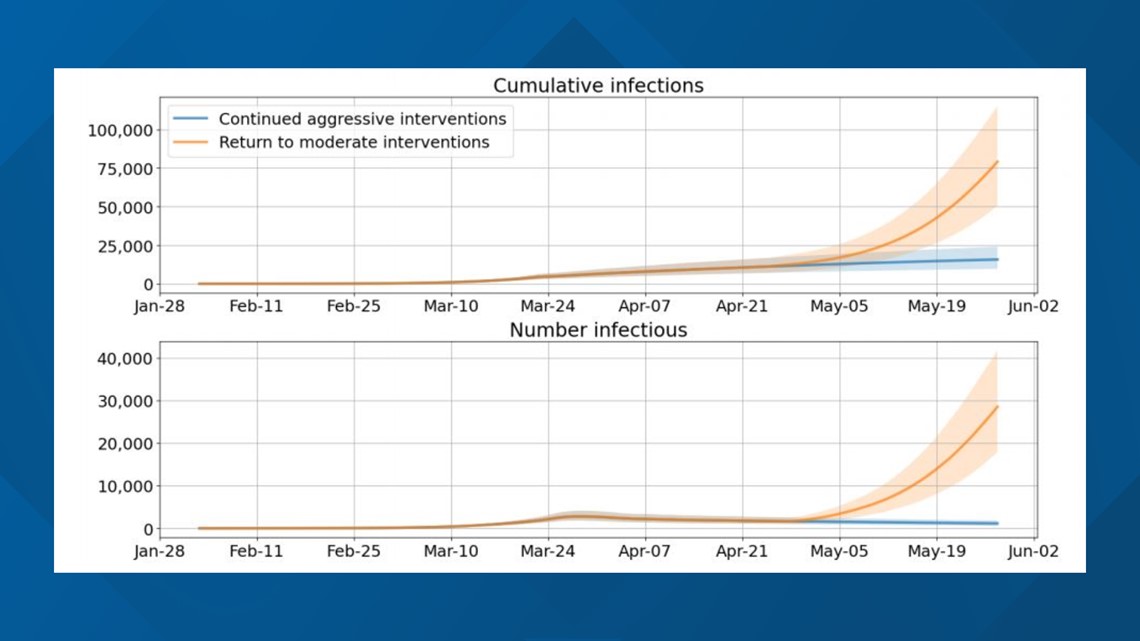PORTLAND, Ore. — Social distancing has prevented an estimated 70,000 people in Oregon from being infected with COVID-19, a new model shows.
Dr. Dean Sidelinger, Oregon’s state health officer, referenced that projection Thursday night during KGW’s coronavirus Q&A show. He said the updated model from the Institute for Disease Modeling in Washington also estimates more than 1,500 hospitalizations were averted due to social distancing.
“That’s thanks to the actions people have taken to stay home and save lives. The sacrifices we’re making are really making a difference in decreasing the spread of COVID-19 here in Oregon,” Sidelinger said.
Researchers estimate there have been 8,400 total infections in Oregon, 1,900 of which were diagnosed by April 16. As of Friday, there are 2,177 total known cases, including 86 people who have died.
The institute projects there’s been a 70% decrease in coronavirus transmission since March 23, when Oregon Gov. Kate Brown issued the statewide stay-home order. Researchers say Google data shows large reductions of movement in the state after the order was issued.
Alternatively, if no social distancing measures were put into place, researchers predict the epidemic would have grown exponentially, and there would have been about 80,000 infections, including 2,000 hospitalizations, in the state by April 16.
“We commend Oregon for introducing interventions early in the epidemic,” researchers said.
The institute also looked at two scenarios moving forward and how the COVID-19 pandemic could potentially be impacted in Oregon. One scenario centered on if current aggressive interventions, like the governor’s stay-home order, stayed in place from April 27 to May 28. In that scenario researchers predict the number of active infections would slowly decline over the next weeks.
The other scenario played out what could potentially happen if Oregon went with “moderate interventions,” such as the governor’s ban on large gatherings and closure of restaurants prior to the stay-home order. Under this scenario, researchers say the number of active infections would rapidly increase from April 27 to May 28.


“Current aggressive interventions will need to be maintained in order to decrease the number of active infections,” the institute concluded.
Sidelinger said reopening the state will be gradual and monitored closely.
“What we worry about as we start to open up Oregon, and people start to mix, is that as people come into contact with more people, they could spread the virus and that’s why in Oregon we are going to take a slow but cautious approach,” he said.
In addition to advising that aggressive interventions, such as the state’s stay-home order, continue, researchers say more work needs to be done before Oregon reopens.
“We emphasize the urgent need for enormously increased testing capacity. It will not be possible to relax social distancing measures and avoid an epidemic rebound without significantly increased testing,” researchers said.
The increased testing must be coupled with detailed contact tracing and asymptomatic testing of at-risk individuals, according to the institute.
Contact tracing and increased testing are a few of the prerequisites Gov. Brown has stated are part of her framework for slowly lifting economic and social restrictions in the state. Earlier this week, the Oregon Health Authority changed the guidelines for COVID-testing to expand to the poll of eligible Oregonians to those with mild symptoms, and in specific circumstance, those without symptoms.
Sidelinger said the state also wants to see a decline in cases and hospitalizations, and have enough personal protective equipment (PPE) for hospitals. The state is expecting a large shipment of PPE, including millions of masks and hundreds of thousands of gloves, gowns and face shields over the next week.
RELATED: Oregon expects to get millions of masks, more PPE before elective medical procedures resume May 1
“Once those things are in place, we’ll look at what those sectors are that need to open up and those discussions are happening with business sectors and other sectors, and recommendations will be made to the governor about what order those things will happen and we hope to have some of those more detailed information in the next week and a half or two weeks," Sidelinger said.
The first step Gov. Brown took to lift restrictions focused on medical and dental facilities, where elective procedures may resume beginning May 1 as long as federal and state safety standards are met.

